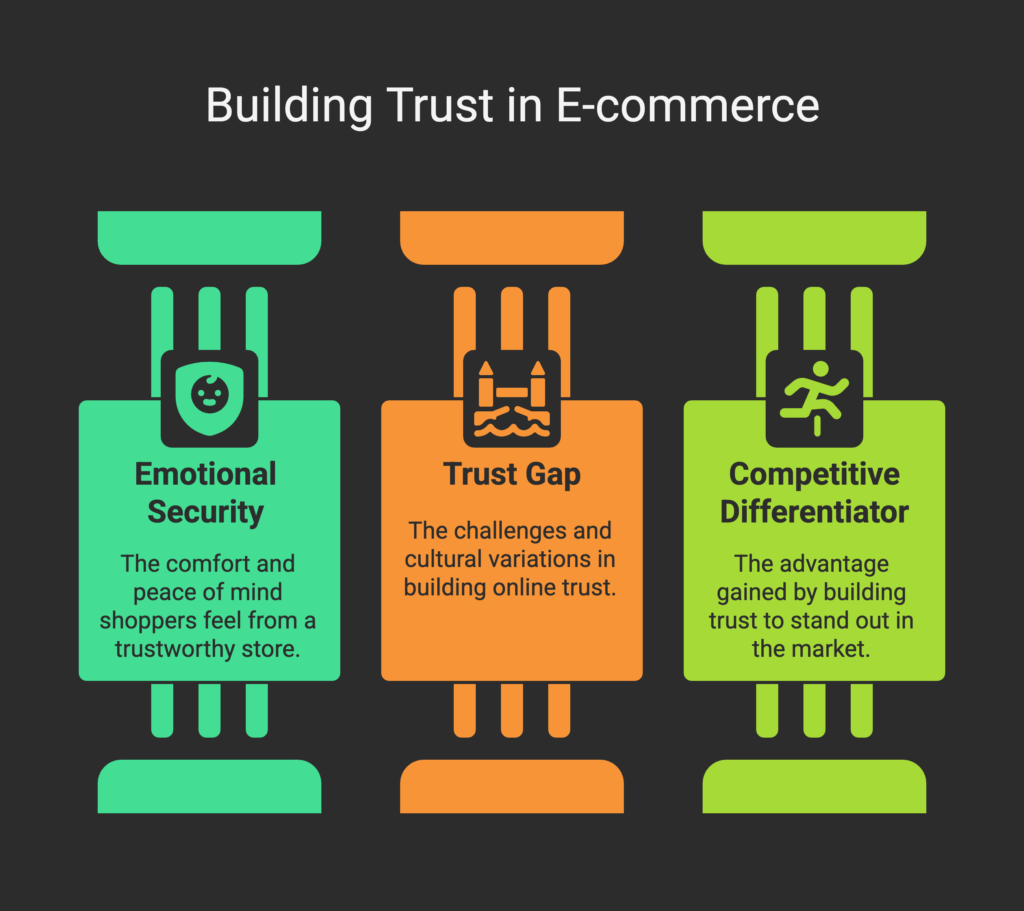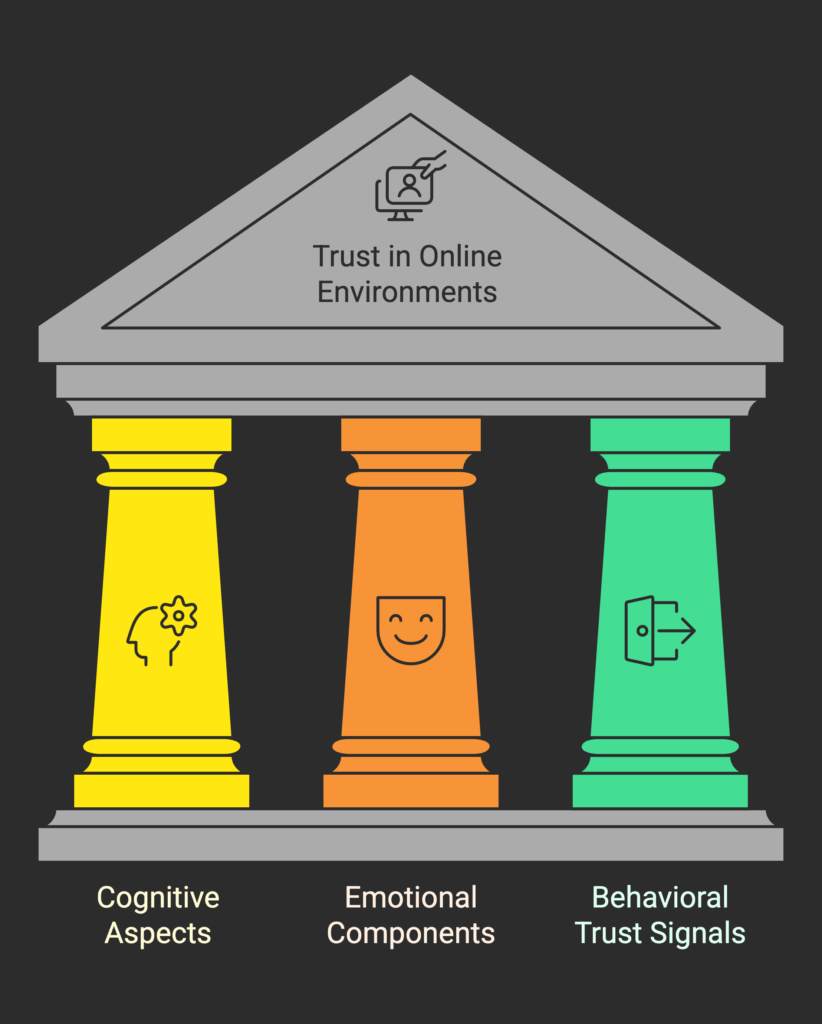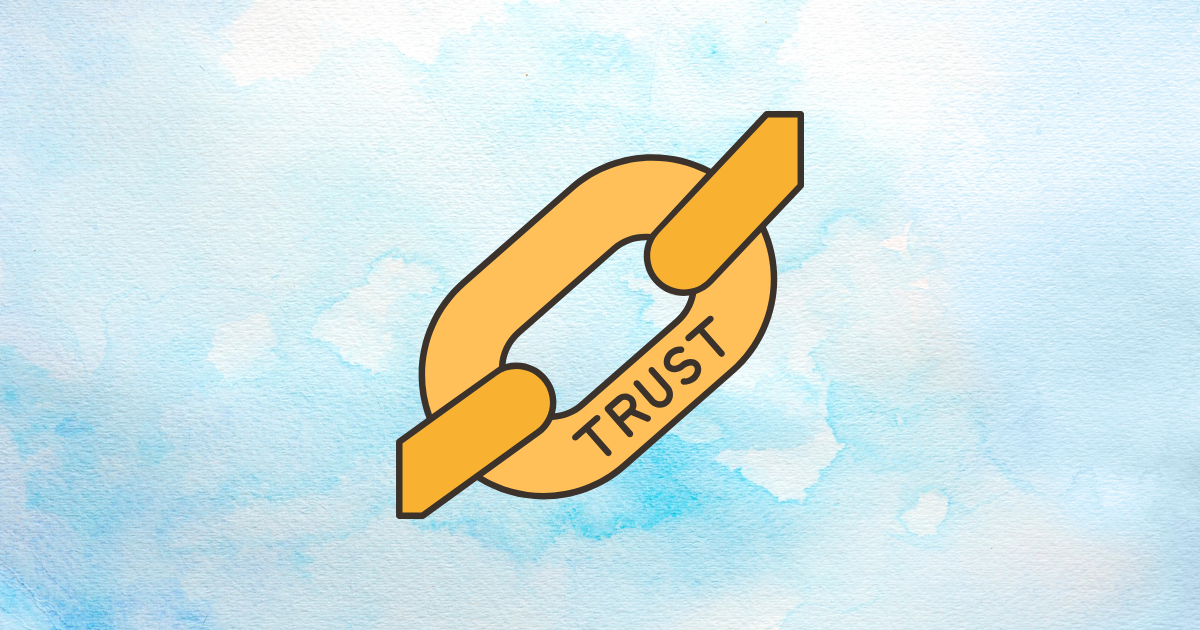Ever felt a little nervous handing over your personal details on a website you’ve never visited before? Wondering if your money and information are truly safe online? By the time you finish reading this article, you’ll have a clear understanding of how trust functions in e-commerce and why it’s vital for your store’s success. Get ready to learn how to build emotional security for your customers, boost conversions, and stand out from competitors. Ready to dive in? Let’s begin!
Introduction to Trust in E-commerce
In this section, you’ll discover why trust matters so much in digital transactions. You’ll also learn about the psychological foundations that make people wary or confident when buying online. Stick around to see how trust can become your secret weapon.

The Psychological Foundation of Online Trust
Trust in digital environments means feeling safe and secure when sharing personal or financial details. Since customers can’t physically inspect products or meet the seller face to face, trust must bridge that gap. Studies show that higher trust often leads to better conversion rates. This is because emotional security helps customers believe that a website is both safe and reliable, pushing them closer to the buy button.
What do we mean by emotional security in online shopping? It’s the comfort and peace of mind a shopper feels from a trustworthy store. This sense of security can make or break a purchase decision. When shoppers feel that warm sense of safety, they’re more likely to complete their transactions instead of abandoning their carts.
But if trust is so important, why does it often feel missing in online stores? Let’s look at the trust gap next.
The Trust Gap in E-commerce
The online world comes with unique challenges: you can’t hold the product in your hands or talk to a sales representative in person. Because of these limitations, customers may hesitate. The cost of low trust is huge—think about abandoned carts and the revenue lost when people walk away at the last second. Additionally, consumer skepticism has grown over time as stories of online fraud and data breaches circulate.
This trust gap can also vary across cultures. Some regions expect clear privacy seals or well-known payment logos before making a purchase. Others might rely heavily on peer reviews or personal recommendations.
Still, building trust can be a real game-changer. Up next: how trust can set you apart from the competition.
Trust as a Competitive Differentiator
When you successfully build trust, you’re not just increasing immediate sales—you’re also setting yourself apart in a crowded market. Competitors that fail to gain trust face a steep challenge. Meanwhile, stores that invest in trust see long-term rewards, including higher customer lifetime value. People come back to businesses they trust, and they often bring their friends along.
So how does trust actually form in a person’s mind? Let’s dig into the psychological side of things next.
The Psychology of Trust in Online Environments
In this section, you’ll understand the mental processes behind trust. We’ll explore how quick judgments, emotional triggers, and actual user behavior all come into play. Ready to see how your customers really think and feel?

Cognitive Aspects of Trust Formation
First impressions happen fast—sometimes in a fraction of a second. Shoppers often rely on “System 1 thinking,” which is quick and automatic, to judge your site’s trustworthiness. Biases like the “halo effect” can influence these judgments. If your site looks credible, people assume other parts are credible too.
Over time, “System 2 thinking,” the more logical side, might kick in. Customers start looking for details like return policies or security badges. Familiarity also plays a huge role. Ever visited a website and thought, “This looks exactly like what I’m used to”? That’s familiarity building trust, often without you even noticing.
But trust isn’t just about logic. Emotions are key too. Let’s explore that next.
Emotional Components of Trust
Emotions guide a big part of our decision-making. If a shopper feels anxious or uncertain, they might abandon the cart. By contrast, if they feel comfortable and confident, they’re far more likely to complete the purchase. Emotional contagion can also play a part: a cheerful and welcoming interface can make customers feel more positive about you.
However, what people say about trust isn’t always what they do. Next, we’ll look at actual behaviors that reveal true trust levels.
Behavioral Trust Signals
Some shoppers claim they “trust” a website, but their behavior might say otherwise. Hesitation or repeatedly checking the same information can be red flags. On the flip side, a smooth user journey—fewer page reloads and no second-guessing—often indicates real trust. If customers feel emotionally secure, they’ll act on it by clicking “Buy.”
So how do you create that sense of security visually? Let’s move on to design and interface details.
Visual Trust Triggers in E-commerce Design
Here, you’ll find out how your store’s look and feel can instantly communicate trust. We’ll cover professional design, interface elements, and the small touches that scream “safe and reliable.” Prepare for a whole new view on design!
Professional Design and Brand Consistency
A visually polished website speaks volumes. If your design looks outdated or sloppy, shoppers will question your legitimacy. Elements like color also matter. Certain colors can imply calm and reliability. Typography sends subtle signals too—clean, easy-to-read fonts reassure users that you’re meticulous about details.
Consistency across touchpoints—like your homepage, product pages, and checkout—helps build trust. When visitors see the same logo placement, color scheme, and layout principles throughout the site, they feel more at ease.
Now that we’ve covered the big picture, let’s look at the specific UI elements that can boost trust.
User Interface Elements That Build Trust
Navigation menus should be clear. Confusing navigation can frustrate people and raise doubts. High-quality images also signal professionalism. Blurry or overly generic stock photos feel suspicious. Loading speeds matter, too—if your site is slow, people might assume it’s unreliable or unsafe.
With more people shopping on phones and tablets, mobile responsiveness is a must. If pages don’t fit on the screen, it sends a message of neglect. Shoppers may think, “If they don’t care about mobile visitors, do they really care about security?”
Of course, design goes beyond general layout. Some elements directly shout “You can trust us!” Let’s talk about those next.
Trust-Enhancing Visual Elements
Trust badges and security seals can instantly calm fears. Payment method icons—like PayPal or well-known credit card brands—further show professionalism. Displaying professional certifications (if relevant) or awards also helps. These signs say, “Real experts back us up.”
Consistent branding throughout the site, including product pages and checkout, reassures shoppers that they’re still dealing with the same business. A jarring switch of style can trigger worry, making people think they’ve landed on a different or fraudulent site.
Next, let’s see how the words and tone you use can boost trust.
Content and Communication Trust Triggers
In this section, you’ll learn how to speak in a way that builds credibility. From clear business details to friendly, plain-language policies, discover how every piece of text can work in your favor.
Transparency in Business Information
Your “About Us” page matters more than you think. It’s a chance to show who’s behind the scenes. Putting faces to names can make your business feel more real. Share your company story, mission, and values to create a genuine bond. When people see real human stories, they trust you more.
Team profiles can highlight expertise. Show the credentials or experiences of key people. This method positions your brand as knowledgeable and caring.
But it’s not just about who you are. It’s also about how you handle rules and policies. Let’s examine that next.
Clear Policies and Terms
Users want to know exactly what they’re getting into. A transparent privacy policy fosters trust by clarifying how data is collected and used. Similarly, clearly stated return and shipping policies help reduce anxiety. Shoppers hate hidden fees, so price transparency is a must.
Keep terms of service straightforward. Overly complicated language can come off as suspicious or trying to hide something. The simpler it is, the better your customers feel.
Of course, the way you speak is also key. Let’s move on to language and tone.
Language and Tone Considerations
If your website sounds too formal or uses too much jargon, you risk confusing and alienating shoppers. Speak clearly and honestly about products and services. Customers appreciate an open, friendly tone—like a helpful friend guiding them. Avoid over-the-top marketing claims that feel exaggerated.
Consistency matters here, too. The same tone across product descriptions, emails, and social media shows that you’re a real, stable brand. That stability strengthens trust.
But even the best words won’t stand alone. Let’s talk about social proof next.
Social Proof as Trust Triggers
Now, you’ll see how real customer reviews, testimonials, and community engagement can reinforce trust. People love to hear what others think, and we’ll show you how to leverage that.
Review and Rating Systems
Reviews can sway a shopper’s decision almost instantly. Star ratings give a quick snapshot of how others felt about their purchase. Interestingly, a mix of positive and slightly critical reviews can sometimes boost credibility. When all reviews are glowing, some customers suspect they’re fake. Always verify your reviews and show signs of authenticity to build confidence.
But reviews aren’t the only way to show happy customers. Enter testimonials and user-generated content.
Testimonials and User-Generated Content
Short quotes can be powerful, but video testimonials can be even more persuasive. Seeing and hearing real customers talk about their experiences adds an authentic touch. User photos, case studies, and success stories bring credibility—especially for industries where results matter (like fitness or finance).
Social media validation is another strong trust signal. If people see your brand loved on Instagram or Facebook, they assume you’re doing something right.
How about harnessing the power of community? Let’s explore that next.
Community and Social Validation
Building an active community around your products gives shoppers a sense of belonging. Seeing “others who bought this also bought…” or real-time purchase updates can create a herd effect, prompting people to join in. Expert endorsements or industry awards add another layer of confidence for the shopper.
Next, let’s talk about security and privacy—two huge pillars of trust.
Security and Privacy Trust Triggers
In this section, you’ll learn how to show that your store takes technical security seriously. We’ll also cover ways to protect customer privacy and reduce risk so that shoppers feel totally safe.
Technical Security Indicators
The presence of SSL certificates (indicated by HTTPS) is a basic but essential sign of security. Shoppers notice the padlock icon in the address bar. Secure payment processing, often backed by well-known gateways, also sends a signal that their data is in good hands. If your site complies with data protection regulations like GDPR, make that clear too.
Security is one thing, but privacy is a slightly different angle. Let’s see how you can reassure customers about their personal data.
Privacy Assurance Elements
Being open about how you collect and use data is critical. Let customers see exactly what you track via cookies or other means. Provide easy ways to opt out or control their data settings. Clear notices and consent forms can go a long way toward making people feel respected.
But sometimes it’s not enough just to promise safety; offering ways to reduce buyer risk is also crucial. Let’s look at those.
Risk Reduction Mechanisms
Money-back guarantees and free returns encourage shoppers to try your products without fear. A price match promise can also help people feel safe by assuring them they won’t find a better deal elsewhere. Purchase protection programs are another level of security, telling shoppers they’re covered if something goes wrong.
Security is one piece of the puzzle, but user experience is just as important. Let’s explore UX next.
User Experience Trust Triggers
This section will show you how site navigation, customer support, and an optimized checkout process can make your store more trustworthy. Ease of use often equals peace of mind.
Intuitive Navigation and Usability
People should find what they’re looking for fast. A clean information architecture with clear categories helps. Search functionality should deliver relevant results, and filters or sorting tools can make browsing smooth. Breadcrumb navigation keeps users oriented, preventing the frustrating “I’m lost” feeling.
But let’s not forget personal interaction. Customer support can make or break trust, so let’s talk about that next.
Customer Support Visibility
Live chat provides immediate help, showing you’re there for your customers. Fast response times build trust by proving you’re active and attentive. Displaying email, phone, or social media contact options also helps. The more channels you offer, the more accessible and trustworthy you appear.
An FAQ section that answers common questions signals that you anticipate needs and care about transparency. Customers feel more secure when their doubts are quickly addressed.
Finally, let’s look at the checkout process. This is where trust needs to be rock-solid.
Checkout Process Optimization
Streamlined steps reduce drop-offs. Show a progress indicator, so shoppers know exactly where they are in the process. Offering guest checkout can comfort those who don’t want to commit to an account yet. Make sure your order summary is crystal clear, including any shipping costs, so people aren’t surprised at the final step.
Now that we’ve covered user experience, how do you actually implement all these trust elements? Let’s find out.
Implementation Strategies for Trust Triggers
In this section, you’ll get practical methods for assessing your site, testing improvements, and measuring the results. Because what’s the point of good ideas without a plan to put them into action?
Audit and Assessment Frameworks
Begin by analyzing your current trust gap. Look at factors like design, content clarity, and security features. Compare your trust signals with competitors to see where you stand. You can also gather customer feedback or run surveys to find pain points.
Once you know your gaps, it’s time to test and optimize. That’s where we’re going next.
Testing and Optimization Approaches
A/B testing is your friend. Test different trust badges, colors, or layout changes to see what resonates best with your audience. Heat mapping tools show where users are clicking and where they might hesitate. Run user testing sessions to listen to how people perceive your brand’s trustworthiness.
But how do you measure success in the long run? Let’s explore that next.
Measurement and ROI Calculation
Track key performance indicators (KPIs) like conversion rate and average order value. Look at the difference in cart abandonment before and after trust enhancements. Over time, monitor repeat purchases for signs of growing customer loyalty. If you see higher lifetime value, you’ll know your trust investments are paying off.
But not all e-commerce stores are the same, right? Different industries need different trust tactics. Let’s dig into that next.
Industry-Specific Trust Considerations
Here, you’ll learn how trust can vary depending on what you’re selling and who you’re selling to. If you deal with high-value items, sensitive products, or global audiences, you’ll want to pay extra attention.
High-Value Products and Services
Luxury or expensive products often require more thorough proof of quality. Customers may want certificates of authenticity or financing options. Offering premium support can help justify the higher price and build trust. Verified reviews or expert endorsements carry extra weight here.
But what if your products are personally sensitive? Let’s see how to handle that.
Sensitive Personal Products
Items like health products or intimate goods require an extra level of privacy. Discreet shipping and billing practices can make customers feel less exposed. For these products, user-generated content might need special handling. People want proof that items work, but they might be shy about sharing details publicly.
Finally, remember that trust signals also vary around the world. Let’s talk about cross-cultural factors.
Cross-Cultural Trust Variations
Different regions have different comfort levels with online payments. Some places rely heavily on cash-on-delivery, while others expect global gateways. Localization matters too. Providing local language support and culturally appropriate imagery can go a long way in building trust. Remember to remain sensitive to local norms and expectations.
Now, let’s look at future trends that might shape e-commerce trust.
Future Trends in E-commerce Trust
In this section, discover how new technologies, shifting consumer mindsets, and changing regulations will affect how we build trust in the coming years. Stay ahead of the curve by understanding what’s next.
Technological Developments
Artificial intelligence can personalize the shopping experience, but it also raises new questions about data use. Blockchain might verify product authenticity or secure transactions in a decentralized way. Biometric authentication could make logins safer but also spark privacy debates. Voice commerce may even change how we perceive trust—no interface to judge visually, just a voice.
But technology isn’t the only thing evolving. Consumers are, too. Let’s talk about that.
Evolving Consumer Expectations
Each generation has its own trust triggers. Younger shoppers might be more comfortable with tech but also demand instant transparency. Big tech companies set high standards for data security, nudging smaller players to keep up. There’s a shift from merely selling products to building relationships and communities.
Meanwhile, regulations are also changing the game. Let’s dive into that next.
Regulatory and Compliance Horizon
Privacy regulations are tightening. Expect to see more requirements for user consent, data handling, and accessibility. Some e-commerce sites may lead the way with self-regulation, showing customers they’re proactive about trust. Balancing legal compliance with ease of use will be key to standing out.
Ready to put it all together? Let’s wrap up with how to make trust a real strategy.
Conclusion: Strategic Implementation
Here, you’ll learn how to blend all these trust elements into one cohesive strategy. We’ll also talk about how trust can keep you competitive and boost your brand’s long-term success.
Holistic Trust Strategy Development
Trust isn’t just something you sprinkle here and there; it needs to run throughout the entire customer journey. Every department—marketing, customer service, design, and IT—should focus on trust principles. Balance short-term sales goals with long-term loyalty and brand-building. Regularly measure how changes affect trust. Keep refining.
But why does all this matter so much? Because trust can become your biggest advantage. Let’s see how.
Competitive Advantage Through Trust
Trust can make you truly unique in a marketplace full of similar products. When customers trust you, they’re less sensitive to price. They’ll stay loyal, share positive experiences, and help you grow. Emotional security is the invisible foundation that makes all this possible.
Finally, a quick note for Shopify store owners: you can further boost trust and sales by using a platform like Growth Suite. It simplifies many of the trust-building elements—from professional designs to optimized checkout—so you can focus on what matters most: delivering an amazing experience.
References
- Makdigitaldesign. (2025, February 17). Using Emotional Triggers in Your eCommerce Design. Link
- Gridlex. (2024). Building Trust in Ecommerce: Addressing Customer Security Concerns. Link
- IconicWP. (2024, December 11). How to Build Trust in Ecommerce with First-Time Customers. Link
- Cadastra. (2024, October 21). Why Trust Signals are so Important for E-Commerce Websites. Link
- Invensis. (2024, December 27). 7 Major Trust Indicators That Convert Online Shoppers. Link
- Nature. (2024, July 11). An analysis of consumer’s trusting beliefs towards the use of e-commerce platforms. Link
- MDPI. (2022, March 25). Designing for Trust on E-Commerce Websites Using Two of the Big Five Personality Traits. Link
- Loyoly. (2025, January 7). 13 ways to build trust in e-commerce and generate sales. Link
- CSUSB ScholarWorks. Online Trust Cues: Perceptions and Application. Link
- ConvertCart. (2024, February 13). 30 Ways to Build Trust FAST (On Your eCommerce Store). Link
- ICEB. Trust, Risk, Privacy and Security in e-Commerce. Link
- Yespo. (2025, March 3). 10 Most Effective Trigger Workflows for Ecommerce. Link
- UCL Discovery. (2010, October 22). Trustbuilders and Trustbusters: The Role of Trust Cues in Interfaces to e-Commerce Applications. Link
- UX Primer. (2023, August 21). Designing for Trust: UX Strategies for E-commerce Websites. Link




